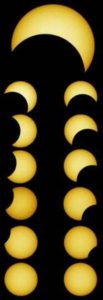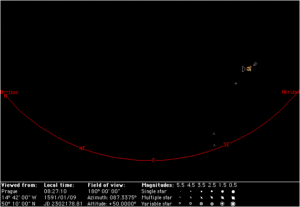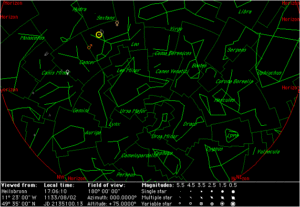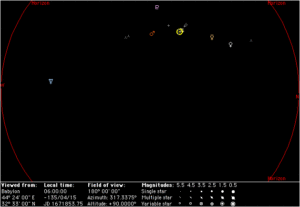
Background image: NASA
In the past several decades, various researchers have sought to “correct” the conventional chronology of ancient and medieval history by deleting one or more centuries. A significant number of these researchers–Rose, Heinsohn, Marx, Whelton, James, Rohl, and various others–were influenced by the writings of Immanuel Velikovsky, who argued that some five centuries needed to be removed from Greek history, thereby eliminating the so-called Dark Ages. Velikovsky also envisioned shifting Ramses II and Hattusilis III forward in time by some seven centuries to the time of Nebuchadnezzar II (c. 600 BCE). For those of us who are not trained historians or intimately familiar with the relevant historical data, it is difficult to know what to make of these seemingly erudite and occasionally arcane arguments. Is it really possible, as Marx and Fomenko would have us believe, that conventional chronology is off by more than a thousand years and that Alexander the Great died in 900 AD? Are we to believe, as Illig and Whelton would have us do, that Middle Age chronology is inflated by two or three centuries? Other revisions, such as that offered by Heinsohn and Illig, are even more radical, calling for a deletion of several millennia at various points since Neolithic times (these two researchers hold that the Great Pyramid at Giza was built some time after 500 BCE!).
A detailed analysis of the specific claims of Heinsohn, Illig, Fomenko and the rest is impossible here and, in any case, would require a legion of scholars trained in various specialized fields of study (archaeology, ancient art and literature, linguistics, radiocarbon dating, ancient architecture, etc). Instead we would propose to focus solely on the issue of whether conventional chronology contains a number of phantom centuries and is capable of being shortened to the extent favored by Heinsohn, Marx, Illig and others. In order to assess such claims, the science of astronomical retrocalculation proves to be an indispensable tool.
As it happens, there exist a wealth of astronomical observations from ancient and medieval times describing solar eclipses, Halley’s comet, and planetary movements against the celestial backdrop. In principle, it should be possible to compare the dates and astronomical observations recorded in the extant historical records with retrocalculated celestial data. If a close match is found between the ancient observations and modern retrocalculations at various points throughout recorded history, it follows that there is no basis for the claim of phantom centuries since it is quite impossible that such a result could be achieved by accident or that the celestial order would somehow “reset” itself in accordance with some preordained plan. Indeed, it is known that precise arrangements of the celestial bodies against the celestial backdrop will not repeat themselves during historical times due to precession of the equinoxes and rotation of the Earth’s axis.
In what follows I offer a representative sample of ancient and medieval astronomical observations in order to provide an overview of the information to be found in such records, much of which is of vital importance for the proper understanding of ancient chronology. Our survey will necessarily be selective and cursory, since there are many thousands of such records available to the historian of astronomy. The records selected will then subjected to analysis by employing either the mathematical calculations of various authorities (Stephenson, Newton, Meeus, Mucke, etc.) or the handy astronomy software Skychart III, which allows for the precise retrocalculation of the sky at any given point in time and space.
In order to test the accuracy of our software, let’s examine an observational report of the renowned astronomer Johannes Kepler from 1591:
“Michael Maestlin of Tubingen and I saw Jupiter totally eclipsed by Mars in the year 1591 on 9 January. The fiery red colour of Mars showed that Mars was inferior (i.e., nearer the Earth).”
Upon directing Skychart III to reconstruct the skies for January 9th, 1591 at Prague–the site of Kepler’s observations–we find that Jupiter and Mars were indeed in conjunction, being so close together as to be virtually indistinguishable (less than 0.01 degrees separated the two planets). [See chart below for the results of the computer simulation] Systematic tests of various other observations of Kepler produced equally dramatic results. One can thus be absolutely certain that Kepler’s observation of a conjunction of Jupiter and Mars accurately described the medieval skies and that the fundamental order of the solar system has not changed since 1591. It also follows from this test that conventional chronology from Kepler’s time until the present is entirely secure in its general outline; e.g. entire years or centuries are not missing.
The all-important question here is the following: How far back into antiquity is it possible to document similar correspondences between astronomical observations and modern retrocalculations?

Having already discussed various planetary observations preserved in ancient Babylonian astronomical diaries, we will here consider ancient eclipse reports. Observational reports of solar eclipses provide a good deal of valuable information for reconstructing ancient chronology. How well, then, do the historical records pertaining to solar eclipses stand up in the light of modern calculations?
The definitive source in this field is the recently published book by F.R. Stephenson, Historical Eclipses and the Earth’s Rotation (Cambridge, 1997). Of the numerous observations of solar and lunar eclipses preserved from the Middle Ages, Stephenson writes that: “In most cases, the date is accurately reported and the precise place of observation is known.” (p. 376) Most important, however, is the fact that the majority of these reports agree with modern retrocalculations: “Most recorded dates when converted to the Julian calendar (or the Gregorian calendar from AD 1582) are in exact accord with the tabular dates of eclipses which according to calculation were large in Europe.” (p. 379)
A few specific examples will illustrate the level of agreement. We have a number of detailed records of the eclipse of August 2nd,1133 from different parts of Europe. The following report comes from a monastery in Germany:
“In the year of the Incarnation of our Lord 1133…on the 4th day before the Nones of August (Aug 2), the 4th day of the week (Wednesday) when the day was declining towards the ninth hour, the Sun in a single moment became black as pitch, day was turned into night, very many stars were seen…” (p. 392, quoting from Notae Halesbrunnenses)
A complimentary report comes from Austria:
“1133. That great eclipse of the Sun occurred on the 4th day before the Nones of August, the 27th day of the Moon, the 13th year of the Indiction. After midday, between the 7th and 8th hours, an eclipse of the Sun was seen in Leo…Very many stars were seen near the Sun; the hearts of many were transfixed, despairing of the light. The Sun, as if it did not exist, was entirely concealed; for about half an hour it was like night. The face of the world was sad, terrible, black, wonderful…” (p. 393)
Setting Skychart III to August 2, 1133 one obtains the following view of the skies (See chart below). As will be noted, the Sun is near Leo when eclipsed and both Venus and Mercury appear in the immediate proximity to the Sun, in close agreement with the report that during the eclipse various “stars” were seen.

There are a number of eclipse reports tracing to the period of the Middle Ages (700 to 900) which Illig and his defenders claim never existed. One of the earliest detailed accounts of a total solar eclipse dates to 812 AD:
“In the year 1123 (Seleucid), on the 14th of Ayyar (=May) there was a total eclipse of the Sun from the ninth to the 11th hours. The darkness was as profound as night; the stars were seen and people lit torches. The Sun eventually reappeared over about an hour.” (p. 423, quoting the Chronicle of Michael the Syrian, Book XII, chapter 7)
An invaluable resource for studying solar eclipses is the monumental Canon of Solar Eclipses 2003 to +2526 by Hermann Mucke and Jean Meeus (Vienna, 1983). This book lists the vital statistics for every single solar eclipse for the past four thousand years, while providing maps of the region of the Earth affected. Turning to the year 812 AD, we find that there was indeed a total eclipse of the Sun on May 14th affecting Syria, the presumed region of Michael’s report. (p. 792).
During the Middle Ages, while much of Europe was shrouded in an intellectual Dark Age, the Arab world was experiencing something of a renaissance of astronomical knowledge otherwise lost since the days of Ptolemy. Although many of the Arab astronomical reports and chronicles remain generally unknown and hidden away in obscure texts, enough have been recovered to indicate the great skill of Arabic astronomers during this period. Indeed, Stephenson remarks that “the eclipse observations made by medieval Arab astronomers are among the most accurate and reliable data from the whole of the pre-telescopic period.” (p. 456)
Consider the following report from 1061:
“(453 AH.) On Wednesday, when two nights remained to the completion of (the month of) Jumada al-Ula, two hours after daybreak, the Sun was eclipsed totally. There was darkness and the birds fell whilst flying.” (p. 439, quoting Ibn al-Jawzi)
Here Stephenson notes that the date provided by Ibn al-Jawzi “is exactly correct.”
Further removed in time from the present is the following report of a solar eclipse from Theon (c. 370 AD), included in his commentary on Ptolemy’s Almagest:
“The exact ecliptic conjunction which we have discussed, and which took place according to the Egyptian calendar in the 1112th year from the reign of Nabonassar, 2 5/6 equal or equinoctial hours after midday on the 24th of Thoth, and according to the Alexandrian calendar reckoned by simple civil days in the 1112th year of the same reign, 2 5/6 equal or equinoctial hours after midday on the 22nd of Payni…And moreover we observed with the greatest certainty the time of the beginning of contact, reckoned by civil and apparent time, as 2 5/6 equinoctial hours after midday, and the time of the middle of the eclipse as 3 4/5 hours, and the time of complete restoration as 4 1/2 hours approximately after the said midday on the 22nd of Payni.” (Theon of Alexandria, 332, quoted in Stephenson, op. cit., p. 364)
The report of Theon, when converted to the Julian calendar, dates to June 16th, 364 AD. As Stephenson points out, this date agrees exactly with modern computations. (p. 364) Turning to the maps provided by Mucke and Meeus, we find that the area of Earth affected by this particular eclipse cuts across a narrow band of Africa, including Alexandria. (p. 762)
The most famous astronomer of all antiquity was Ptolemy. His Almagest, written around 150 AD, includes a handful of eclipse observations. Various writers, including Robert Newton, have suggested that Ptolemy doctored his data or reported as observations phenomena that were, in reality, calculations. How well, then, do the solar eclipses mentioned by Ptolemy in the Almagest measure up against modern retrocalculations? According to Stephenson, of the six observations included by Ptolemy, “in every case, the reduced date is in exact accord with that of a tabular eclipse.” (p. 369).
As is well-known, Ptolemy used ancient Babylonian observations in formulating his astronomical theories. The earliest eclipse record cited by him dates to 721 BCE. Dozens of ancient Babylonian eclipse observations are still extant. Here, too, Stephenson found that the vast majority of dated astronomical reports agreed closely with modern retrocalculations. Consider, for example, the sole total eclipse recorded in Late Babylonian texts–that of April 15th, 136 BCE. The relevant portion of this text (BM 34034=LBAT 1285), as quoted by Stephenson, is as follows:
“SE 175, month XII2. The 29th, solar eclipse. When it began on the south-west side, in 18 deg daytime in the morning it became entirely total…(It began) at 24 deg after sunrise.” (129)
A goal-year text from Babylon includes additional information of interest with regards to this particular eclipse:
“SE 175, [king] Arsaces, [month XII2]. The 29th, at 24 deg after sunrise, solar eclipse; when it began on the south and west side, […] [Ven]us, Mercury and the Normal stars were visible; Jupiter and Mars, which were in their period of invisibility, were visible in its eclipse […].” (“Stephenson, pp. 129-130)
Turning to the maps provided by Mucke and Meeus, we find that a total eclipse occurred on April 15th, 136 BCE (p. 728). The affected area included the greater part of Asia and portions of the Persian gulf. If we now turn to Skychart III and set the skies to April 15th, 136 BCE, it will be found that Jupiter and Mars were indeed very close to the Sun on this date, making their sudden appearance during the eclipse of the Sun a notable sight (See chart below for a map of the Babylonian skies). Venus and Mercury were also present, as reported by the Babylonian astronomer. This test–together with the calculations provided by Mucke and Meeus–constitutes a dramatic confirmation of the accuracy of the Babylonian observations.

Yet this record is hardly unique for its accuracy. With regards to the solar eclipse of 190 BC, Stephenson offered the following summary of Late Babylonian eclipse reports:
“When converted to the Julian calendar, the above date (BC 190 Mar 14) proves to be in exact accord with that of a tabular solar eclipse (e.g. as listed by von Oppolzer, 1887). Such accuracy is characteristic of all Late Babylonian observations of both solar and lunar eclipses for which a date is well preserved.” (F. R. Stephenson, Historical Eclipses and Earth’s Rotation, 1997, p. 121)
Although Babylonian astronomical observations can be traced to roughly 700 BCE, reliable reports of solar eclipses are only preserved from the fourth century on (Stephenson, op. cit., p. 128). This gap in our knowledge can be filled, to some extent, by considering the astronomical observations from ancient China, where records of solar eclipses go nearly four centuries further back in time. Of the oldest Chinese chronicle still extant, Stephenson wrote as follows:
“The only state chronicle of ancient China which is still intact–possibly as a result of the ‘Burning of the Books’ at the command of Emperor Ch’in Shih Huang-ti in 213 BC–the Spring and Autumn Annals records as many as 36 eclipses of the Sun. This series of observations, which commences with the event of Feb 22 in 720 BC, is the earliest from any part of the world…Nearly all dates, when so reduced, prove to be in exact accord with those of eclipses listed in modern tables. This is a remarkable result for such an ancient work and it gives strong support to the authenticity of the purely historical data recorded in the Classic.” (pp. 221-223).
A Chinese account from 709 BCE is the earliest report of a complete obscuration of the Sun in any civilization:
“Duke Huan, 3rd year, 7th month, day jen-ch’en [cyclical day number=29], the first day (of the month). The Sun was eclipsed and it was total.” (p. 226)
Of this particular report, Stephenson offered the following commentary: “The recorded date, when reduced to the Julian calendar, agrees exactly with that of a computed solar eclipse.” (226)
According to the Canon of Mucke and Meeus, a total solar eclipse occurred on July 17th, 709 BC (p. 171). Turning to the maps provided by F.R. Stephenson and M.A. Houlden in their Atlas of Historical Eclipse Maps: East Asia 1500 BC-AD 1900 (Cambidge, 1986), we find that a total eclipse affected a portion of China on July 17, 709 BCE (p. 99).
With regards to the records dated after the Han period, Stephenson wrote as follows: “It should be emphasised that throughout Chinese history from the Han onwards, recorded dates of solar eclipses, when converted to the Julian calendar, usually agree precisely with the calculated dates of these phenomena.” (p. 230)
Having traced solar eclipse observations back well over two thousand years, we have found a striking accord between the ancient observations and modern retrocalculations. It follows from this finding that the historical reconstructions offered by Heinsohn, Marx, Illig, Whelton and others–in which several or more centuries are to be deleted during the past 2500 years–are untenable.